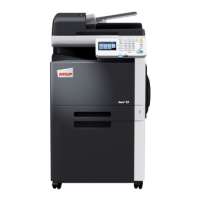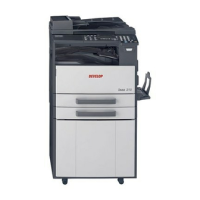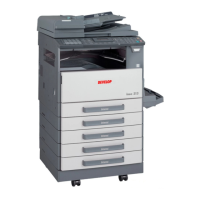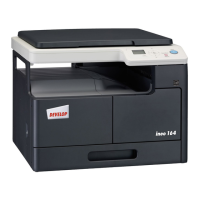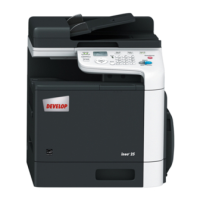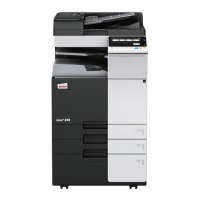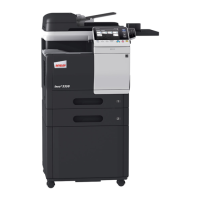Do you have a question about the Develop ineo+ 650 and is the answer not in the manual?
Details on operation, maintenance, and safety precautions for the machine.
Provides precautions for power source, operating environment, and storing copies.
Describes the various parts and functions of the machine's control panel and touch panel.
Explains the basic and quick copy screens that appear when the machine is ready.
Details how to turn on the machine's main power switch and auxiliary power key.
Provides instructions on how to load paper into tray 1 and tray 2.
Provides instructions on how to load paper into tray 3.
Provides instructions on how to load paper into tray 4.
Provides instructions on how to load paper into the Large Capacity Tray (LCT).
Explains how to feed paper manually through the bypass tray for various copy needs.
Describes methods for feeding documents into the ADF or onto the original glass.
Explains how to select paper size automatically or manually for copy jobs.
Details various settings for sorting and finishing copies fed into the output tray.
Describes how to store frequently used copy settings as programs for easy recall.
Explains how to recall and use programmed copy settings (Mode Memory) for copying.
Explains how to save scanned documents in user boxes for later retrieval or printing.
Explains common settings and buttons available across all tabs in the PCL driver.
Details settings in the Basic tab, including paper size, paper tray, and output method.
Explains settings for stapling, saddle stitching, hole punching, folding, and output trays.
Covers common settings and tabs for the PostScript driver, similar to PCL.
Provides general information and procedures for sending faxes, including internet and IP address fax.
Explains common settings and tabs for the Windows fax driver.
Explains how to save copy documents into user boxes and lists savable settings.
Describes how to save scanned images in user boxes, including direct input and user box modes.
Explains how to save printouts into user boxes using the network printer driver.
Explains how to print documents from user boxes, including available print settings.
Details how to print documents saved in the secure print user box, requiring authentication.
Explains how to print documents saved in the encrypted PDF user box, requiring a password.
Explains how to register and recall scan/fax programs for frequent use.
Details how to send scanned data as an e-mail attachment to specified addresses.
Explains how to send scanned data directly to a specific computer on the network via SMB.
Describes how to send scanned data to an FTP server on the network.
Covers detailed settings for scanning and transmission, including original type, resolution, and e-mail settings.
Provides general information and procedures for sending faxes.
Explains methods for specifying a single fax destination from registered, direct input, or program sources.
Describes how to send a fax to multiple destinations simultaneously.
Explains how to send faxes using pre-registered program buttons for efficiency.
Provides information on redial functions (auto, manual) and handling send errors.
Describes how to schedule fax transmissions for a specific time, potentially at lower costs.
Provides general information and procedures for sending internet faxes.
Details general operations and procedures for sending faxes using IP addresses.
Explains methods for specifying a single destination for internet or IP address faxes.
Describes how to send faxes to multiple destinations simultaneously via broadcast transmission.
Explains how to send faxes using pre-registered program destinations for efficiency.
Provides information on redial functions and handling send errors for network faxes.
| Printing Technology | Laser |
|---|---|
| Print Speed (Black) | 65 ppm |
| Hard Drive | 250 GB |
| Duplex Printing | Yes |
| Copy Resolution | 600 x 600 dpi |
| Scan Resolution | 600 x 600 dpi |
| Paper Capacity | 1, 150 sheets |
| Standard Paper Capacity | 1, 150 sheets |
| Print Resolution | 1200 x 1200 dpi |
| Automatic Document Feeder | Yes |
| Functions | Print, Copy, Scan |
| Copy Speed (Black) | 65 ppm |
| Network Connectivity | Ethernet |
| Connectivity | Ethernet |
| Operating System Compatibility | Windows, Mac, Linux |
